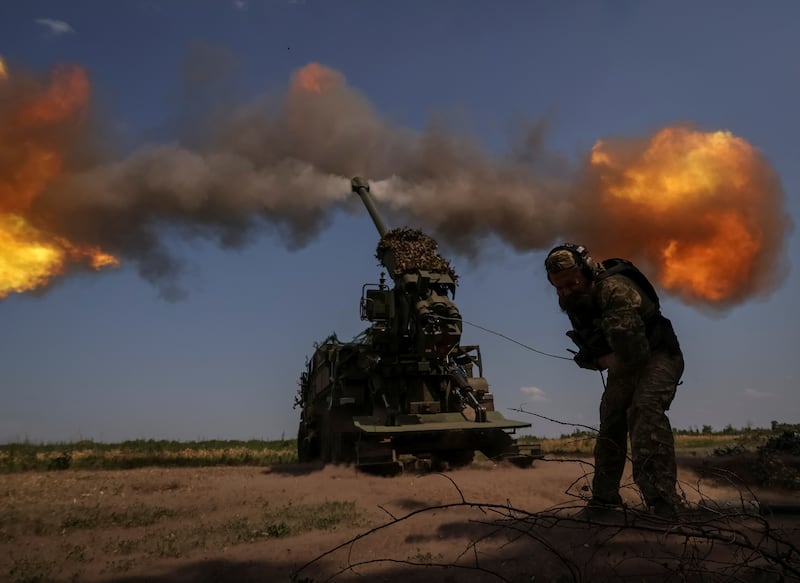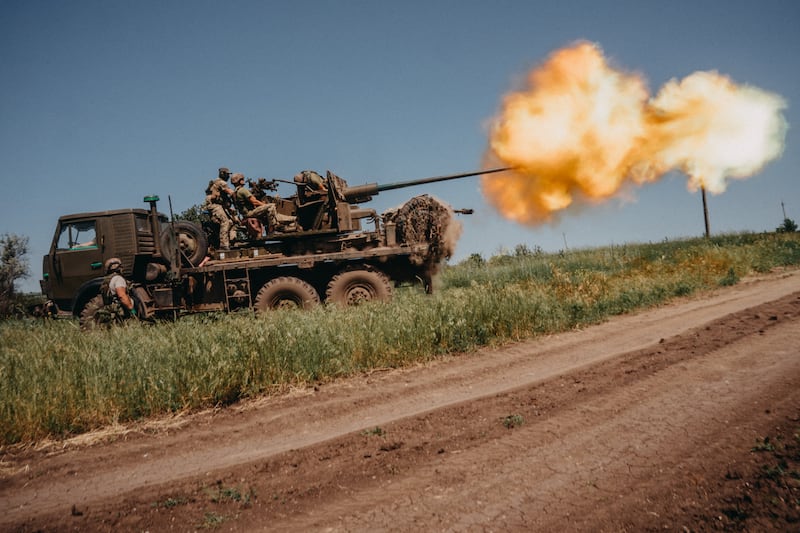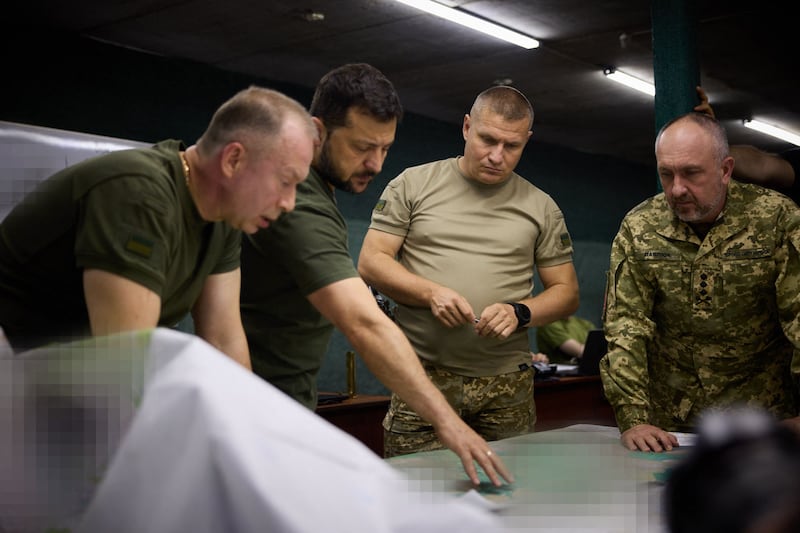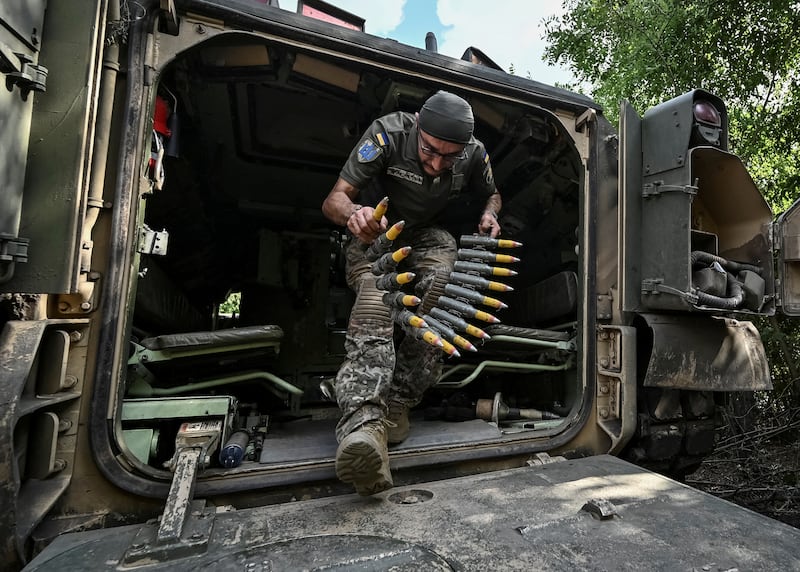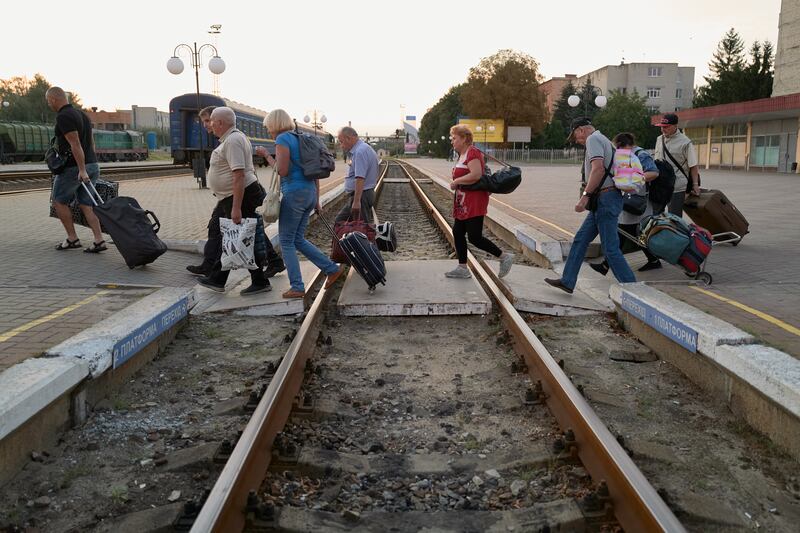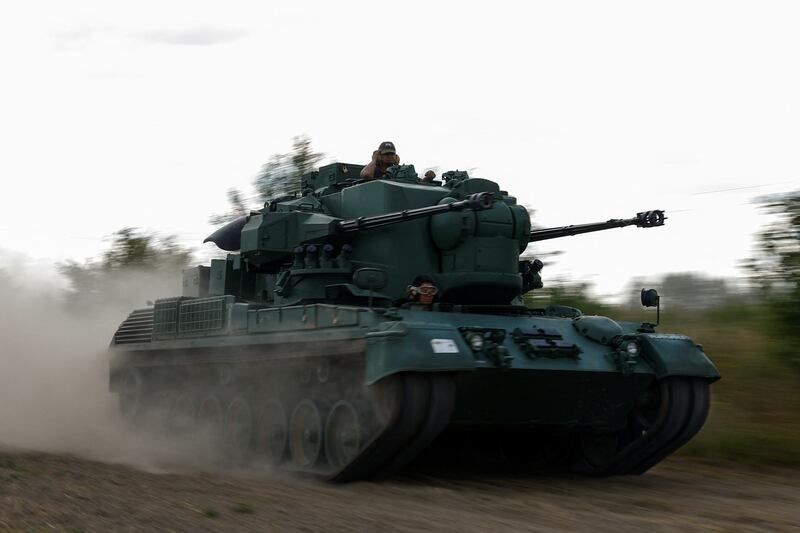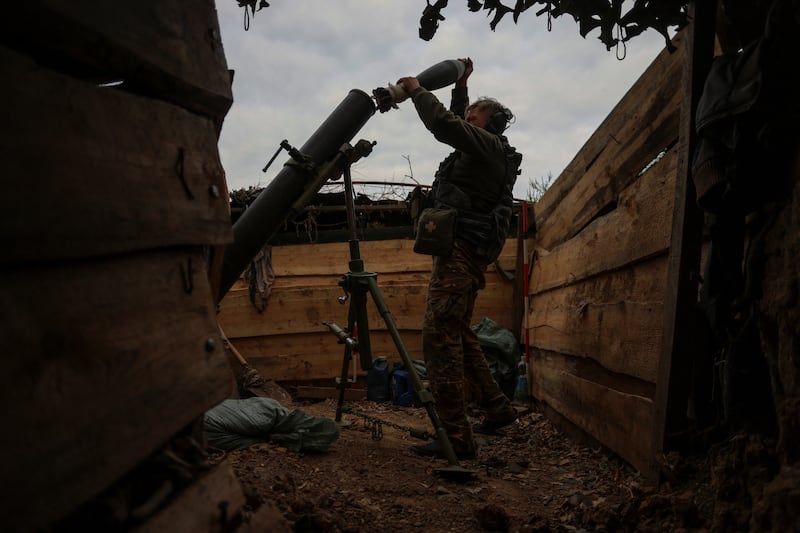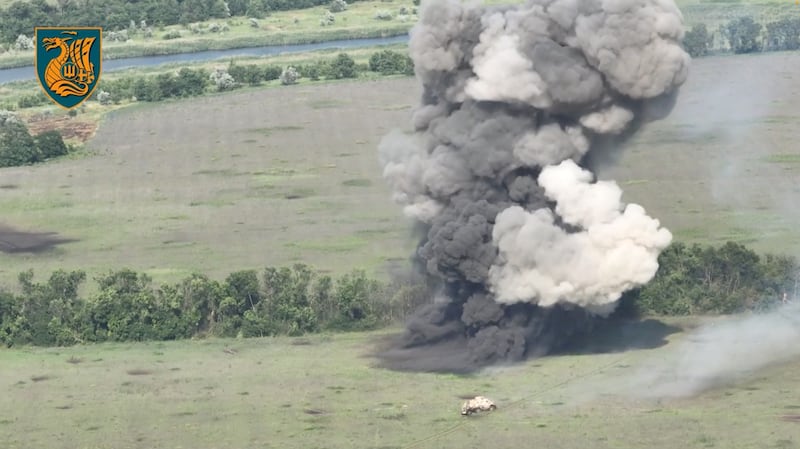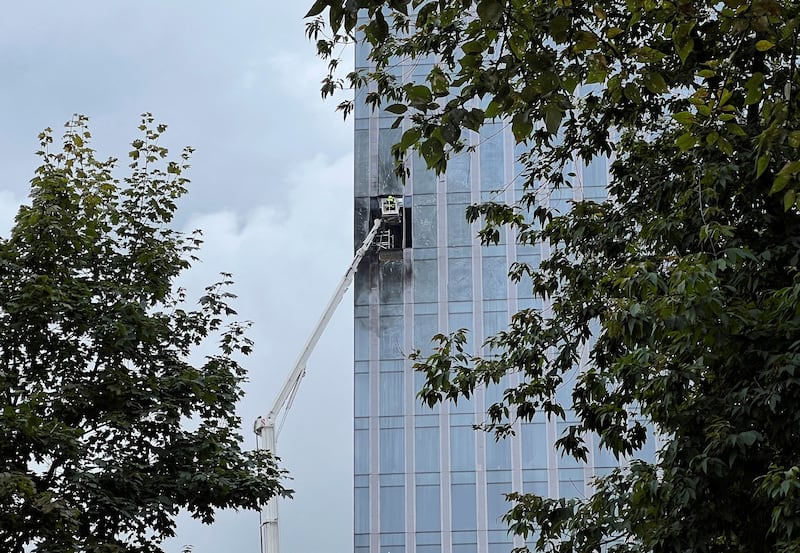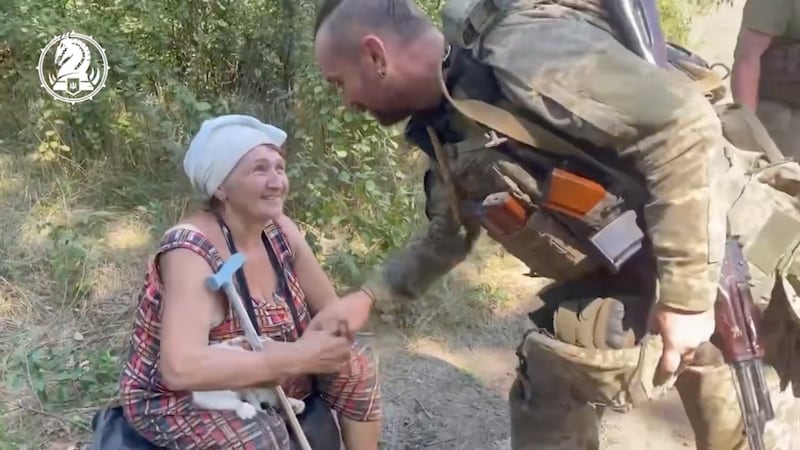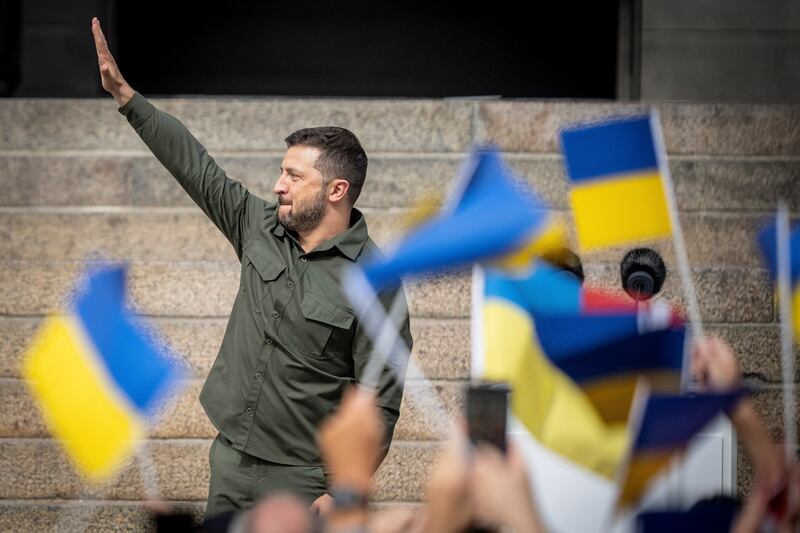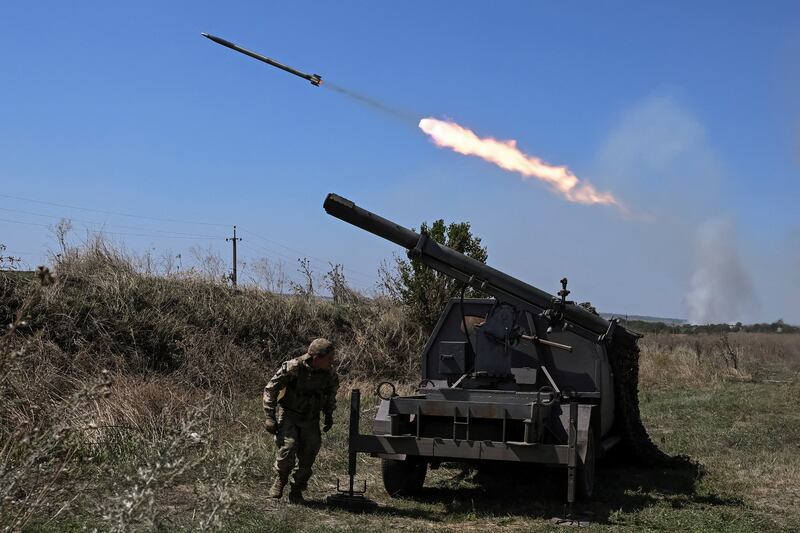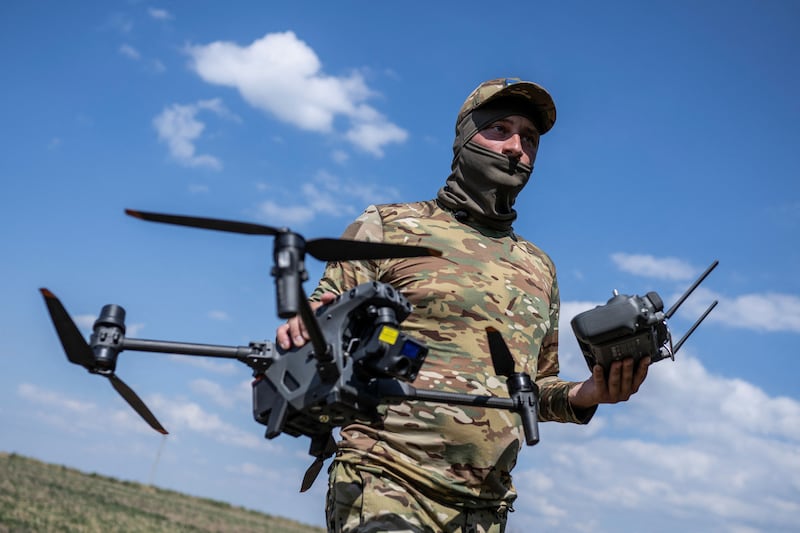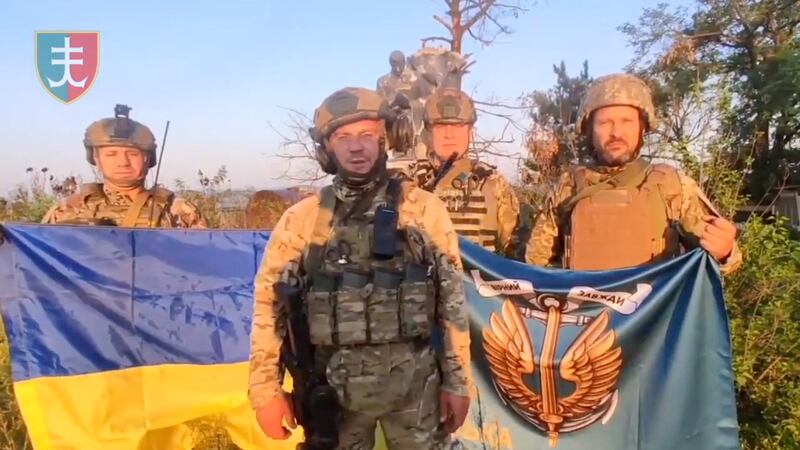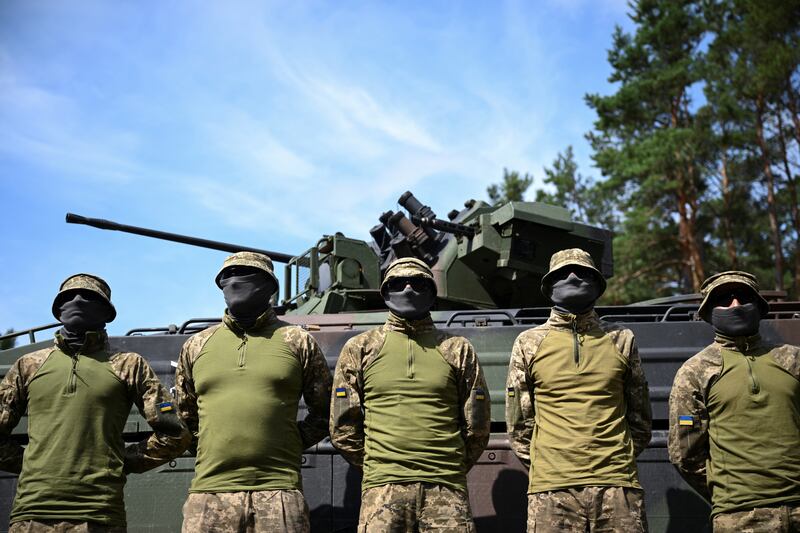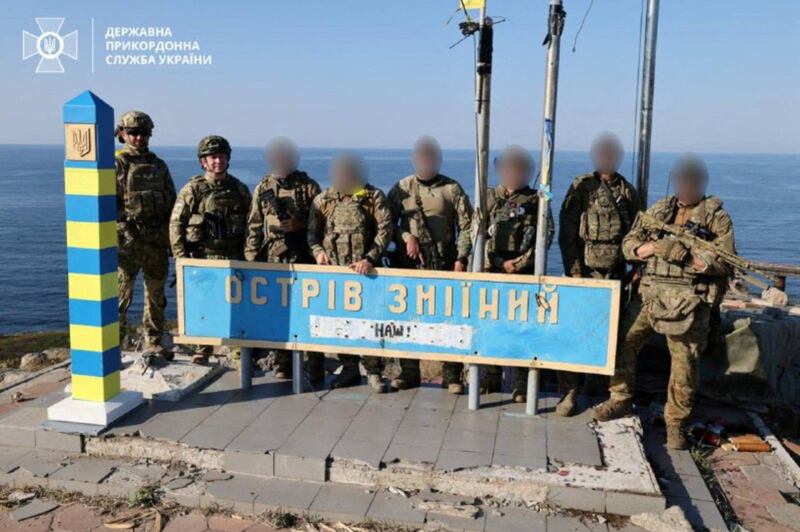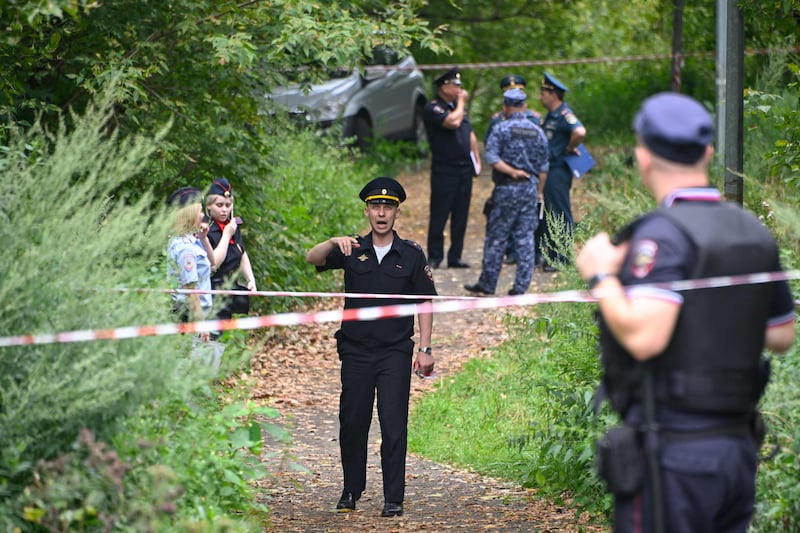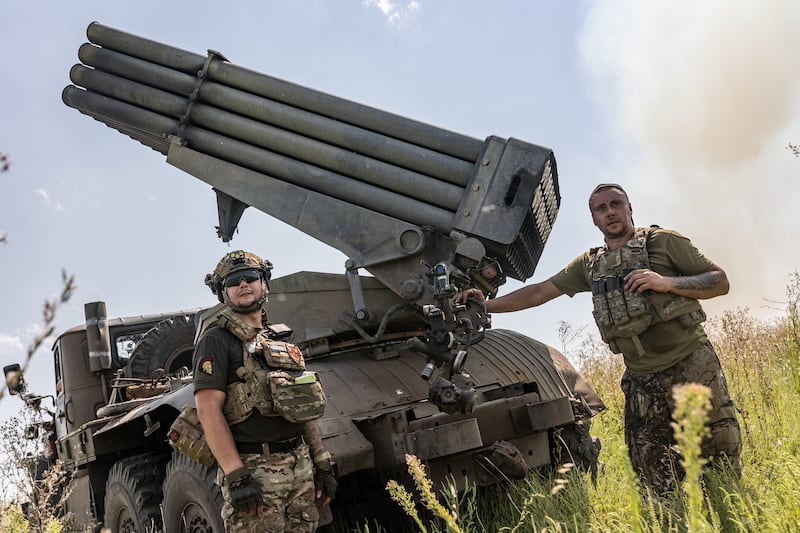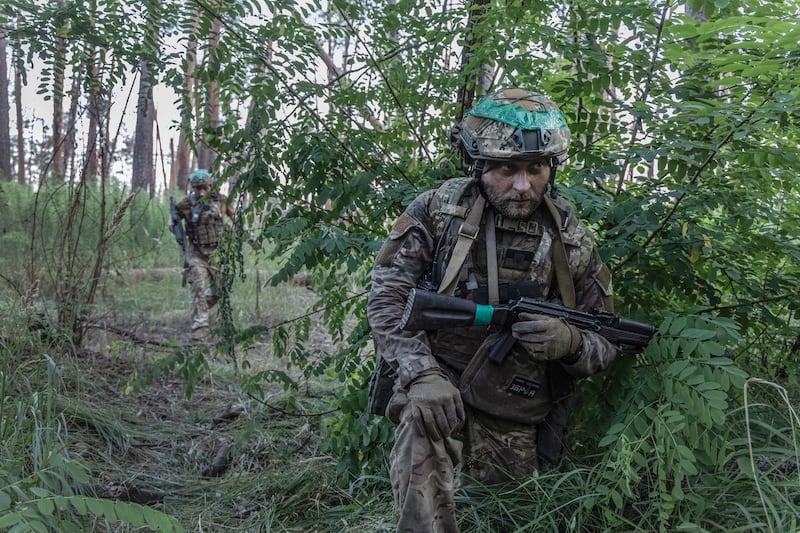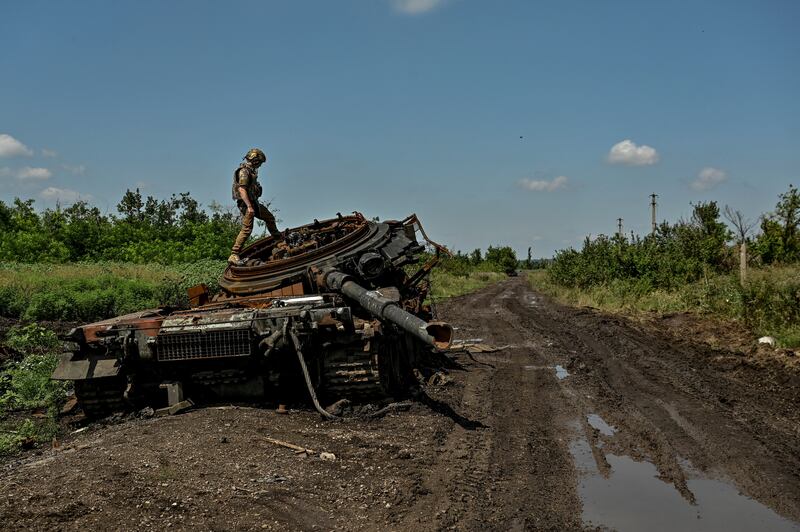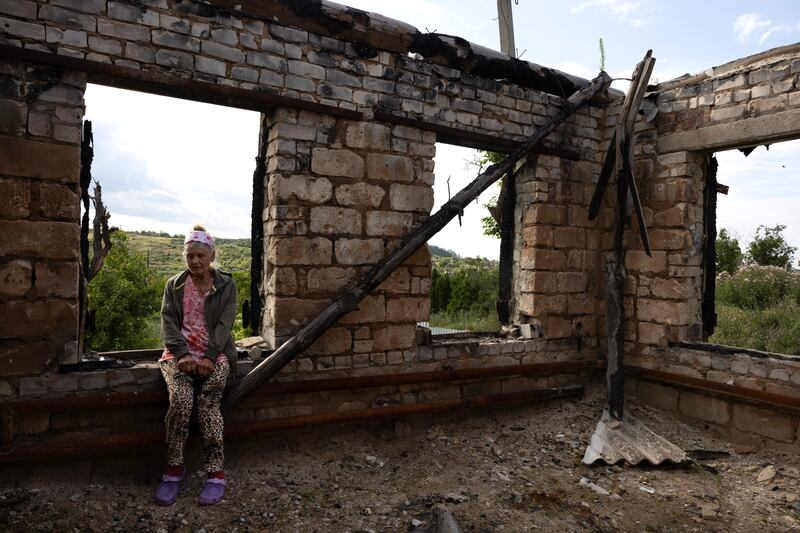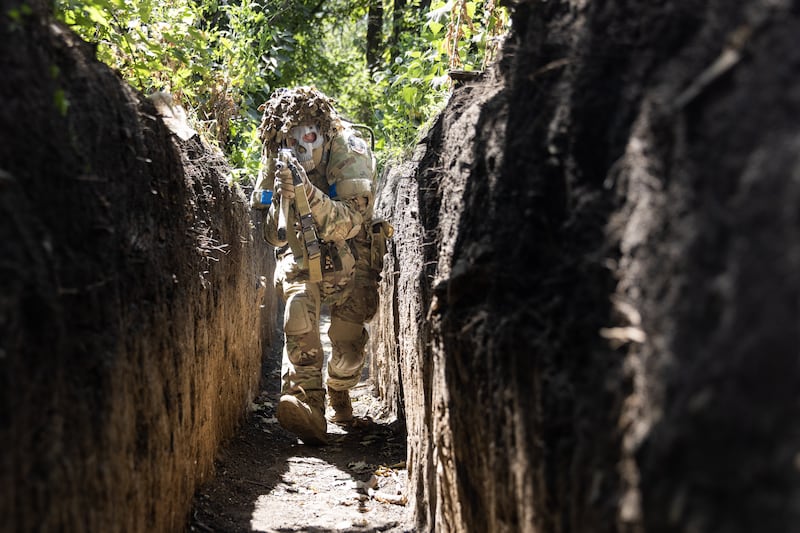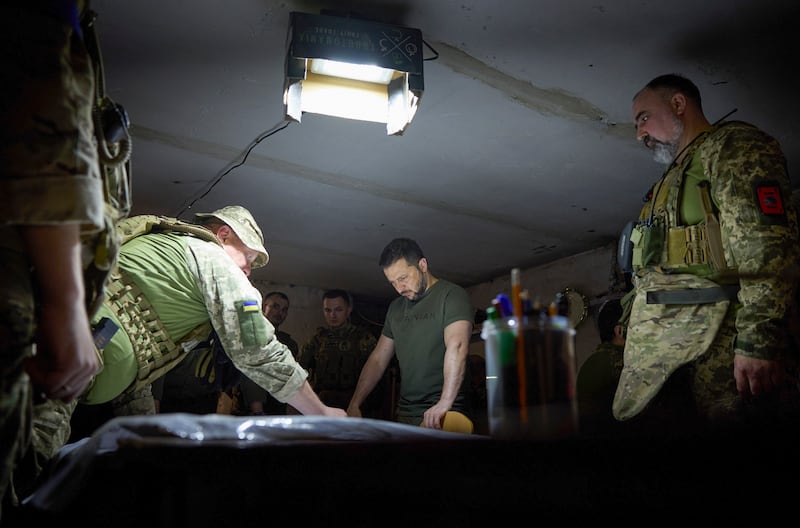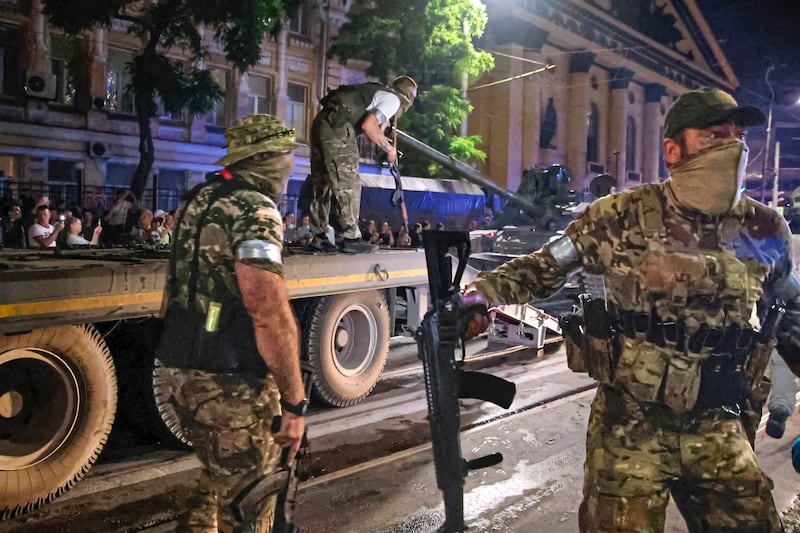In the early hours of Sunday, June 4, tanks and armoured infantry of the dozen new Ukrainian brigades were poised to retake their seized homeland.
The 40,000 soldiers from 10 corps nervously waited for what many would be their first taste of combat, not knowing how they would respond to gunfire, death or injury.
The intelligence suggested that ahead lay Russian minefields, machine-gun lanes, artillery killing zones and a deeply entrenched enemy.
But the troops were reassured that they would be safe in their well-protected, western-supplied Leopard 2 tanks and Bradley armoured fighting vehicles.
Using special snake-like explosive devices, holes were blown through the minefields to a depth of more than 100 metres, clearing a lane six metres wide.
The tanks poured through, powering towards the Russian lines. But mines were struck and artillery homed in causing a pile-up of armoured vehicles, presenting a picture of apparent failure that was widely published by Moscow. It also cost Ukraine two companies' worth of equipment.
The art of combined arms warfare, using armour, artillery, combat engineers and air power – the latter clearly lacking in Ukraine – to penetrate heavily defended lines is something that takes professional armies years to master.
Historical comparisons are tricky but give a sense of what happens in protracted campaigns such as the current frontline showdown. The time frame for the counter-offensive could be measured against the notorious First World War Battle of the Somme, in which the so-called new army advanced about 10km along a 40km stretch of territory during fighting that started on July 1 and ended on November 18, 1916.
Another is the eight weeks it took the UK and US-led forces to break out from the Normandy landings in 1944, when they swiftly rolled up the German army, pushing them out of France.
Hopes of a rapid breakthrough in southern Ukraine, with an armoured column tearing down to the Sea of Azov cutting the Russian front in two, have significantly diminished since early summer.
But the Ukrainians cannot be underestimated. They beat back an invasion by one of the world’s mightiest armies last year, demonstrating agility and skill. They have learnt to adapt and overcome.
On Tuesday it will be precisely 100 days since the counter-offensive was launched. The National spoke to leading military experts on how the operation has succeeded or failed and what might come next.
Civilian soldiers
“Big wars are fought, won and lost by civilians, not by professional soldiers because of the attritional turnover in the opening rounds,” said Gen Sir Richard Barrons, the UK’s former chief of Joint Forces Command.
“If you're creating a big citizen army, you need people willing to fight and Ukraine has got loads of those. You need equipment and that's been a struggle. You need training. And what has become clear in the counter-offensive is that it takes time to train people to be good at land manoeuvre warfare.”
In early June it became very clear that a blunt armoured thrust was going to lead to unsustainable casualties and equipment loss.
Without the air power to pummel Russian defences – as the massed US Air Force did for six weeks on Iraqi positions in 1991 – the Ukrainian were exposed to a barrage of incoming fire from land and air.
They had to leave their armoured protection and, mostly at night, get into the minefields, removing the devices by hand, as British engineers had done clearing lanes through eight kilometres of mines in the Battle of El Alamein in 1942.

Dismounted infantry
Unable to mount brigade or even battalion-size attacks, the Ukrainians developed tactics using company-sized assaults with Bradleys and a handful of tanks providing support.
First the sappers would clear mine lanes then accurate artillery would pepper the enemy positions before the infantry moved forward, dismounting from their protected vehicles to attack the enemy trenches.
The going was hard. Southern Ukraine is a beautiful landscape of giant, meandering fields framed by trees and hedges. But in among that vegetation the Russians built deep defences with firing points and communication trenches to allow safe extraction.
The Ukrainians adapted, with company commanders using artillery smoke rounds to create screens to hide flanking advances.
Unmanned aerial vehicles also played a major role on both sides, in reconnaissance but also as “loitering munitions”, the name for kamikaze drones that fly before identifying a target.

Close quarter battle
The fighting was brutal and frequently at very close quarters. Head camera and drone footage shows Ukrainians firing bullets into vegetation followed by one grenade for every Russian dugout.
Casualties have been high. Some estimates put the Ukrainian losses at 100 a day, which would make it 10,000 in total by Tuesday, a quarter of the assault force. The Russian figures are likely to be more because they do not have the western-supplied protection that has saved countless Ukrainian lives.
“The casualties on both sides are really high,” said Sam Cranny-Evans, a fellow of the Rusi think tank. “It's really a question of who is able to carefully protect their forces the best. The side that wins out in that is likely to come out successful in the war.”
To “fix” the Russians along the 1,000km front line, Ukraine made three lines of attack, around the besieged town of Bakhmut, on the Donetsk-Zaporizhzhia border and farther west around the settlement of Robotyne, the latter being their main effort.
The Ukrainians have “worked hard to select the right place to apply pressure” Mr Cranny-Evans said. “And they probably knew they had one bite of the cherry and it had to go well, as there's not the ability to replace a lot of that equipment in a timeframe that's meaningful.”
Other defence experts made the point that Ukraine put its untested new troops into the better western equipment, leaving its veteran brigades elsewhere. Some basic mistakes were made such as waiting two hours after an artillery barrage had lifted before attacking, or mistakenly entering minefields.
But they have rapidly learnt from mistakes. “The Ukrainians now know how to defeat a well planned, thoughtfully laid out and competently executed Russian defence, but it is hard and it is slow.” Gen Barrons said.

Smart Russians
“The Russian armed forces are currently probably at their best that they've been since the offensive started, they've gained a lot of experience”, Mr Cranny-Evans said.
An insightful Rusi report published on Monday revealed just how well the Russians were doing.
“Russian forces are fighting more competently and with reasonable tenacity in the defence,” said the report, titled Stormbreak: Fighting Through Russian Defences.
While losing ground, they had conducted orderly withdrawals effectively slowing down Ukrainian advances “imposing a considerable cost in equipment”.
Quickly spotting the effectiveness of Ukraine’s explosive mine clearance, the Russians moved their minefields from 120m to 500m in depth and stacked anti-tank mines three high, which destroyed the steel ploughs of mine-clearing vehicles.
They have also used their anti-tank guided weapons (ATGW) to great effect with four launchers equipped with 50 missiles per treeline.
The ATGW teams, who often place cameras on trees in the next field ahead, allow advances to come past them before opening up on the flanks.
The Russians have also finessed their philosophy of artillery being “the god of war” forced upon them by devouring ammunition during saturation barrages in last summer’s pedestrian offensives.
Instead they are producing Krasnopol 152mm laser-guided shells and using drones to designate targets, meaning less ammunition is expended.
“This is a concerning trend, as over time it will likely significantly improve Russian artillery,” the Rusi report said.
The use of Lancet loitering drones has been extensive, allowing them to strike armoured vehicles, most recently hitting the first British-made Challenger 2 tank to be disabled by enemy fire after it hit a mine earlier this week.
Likewise, their Ka-52 attack helicopters have fired their anti-tank missiles, popping up from treelines 8km away. The Russian air force has also finessed its ability to drop precision and thermobaric bombs.

Salient
Ultimately, for Ukraine it is about fighting every step and “weakening Russian will and capability” alongside unsettling public opinion by continued drone attacks on Russia itself, Gen Barrons said.
But in the past fortnight the offensive’s pace has ticked upwards with the Ukrainians penetrating the trenches of the Surovikin line and thrusting through Robotyne.
A salient, or bulge, has grown, with its tip pointing towards the key strategic crossroads town of Tokmak, 20km distant.
The advance has allowed them to bring up artillery and Himars precision missiles that, with their 70km range could soon strike the key M14 motorway that links mainland Russia to annexed Crimea.
But creating a salient is also a point of danger, with its long and exposed flanks “becoming very vulnerable” to a Russian assault that could “cut it out” with a flanking attack, Gen Barrons said.
To exploit the salient the Ukrainians should be pouring armoured brigades into the breach that can break out and cause devastation in Russia’s rear.
But without proper air defences this armoured column could also get stacked up and be picked off at range by Russia’s air force.
“We also just don’t know just how much of 10 corps they’ve got left,” Gen Barrons said.
The Russians have also been doing a lateral reinforcement, taking their veteran VDV airborne troops from the north-east to the Robotyne area.
It is also unknown – and unreported – just how effective Ukraine’s “deep battle” has been using its long-range missiles such as the British-supplied Storm Shadow cruise missiles to strike rear areas.
“These efforts may set Ukraine’s forces up for break-out success or at least to significantly diminish Russia’s combat power,” Brig Barry said.
“Ukraine is clearly aiming for the deep battle – combined with repeated attacks along the lengthy front line – to bring Russian forces to a tipping point where combat power and morale may begin to break.”

Who will win?
The coming weeks will determine how far Ukraine has evolved the right tactics to continue pushing Russia back before the autumn rains arrive.
The winner of the war will be the side that can provide its troops with the most ammunition while preserving lives.
In that respect Nato allies have been a poor support in neglecting to upscale their production lines. “A failure of western industrial defence industry policy has meant this counter-offensive has been limited,” Gen Barrons said. It was only the belated US supply of hundreds of thousands of cluster shells that allowed Ukraine to sustain its attack.
“Are the Russians going to crack or will the they hold the line by moving more seasoned troops around and more firepower?” Gen Barrons said. “What has Ukraine got left in the locker, because if it has expended too much of 10 corps just to crack the front line, then it doesn't have the ability to exploit Robotyne.”
Brig Barry said the Ukrainians “are in it for the long term” and will want to keep up the pressure.
But Mr Cranny-Evans said the war was “approaching a point where it could go either way”.
“The Ukrainians could pause, but I think the likelihood is that they are under political pressure and they will keep pressing as long as they possibly can,” he added.
